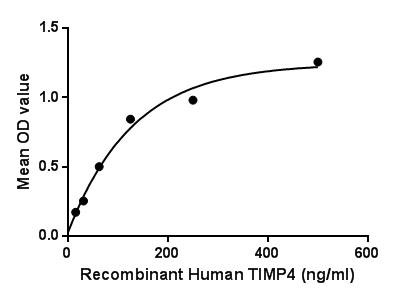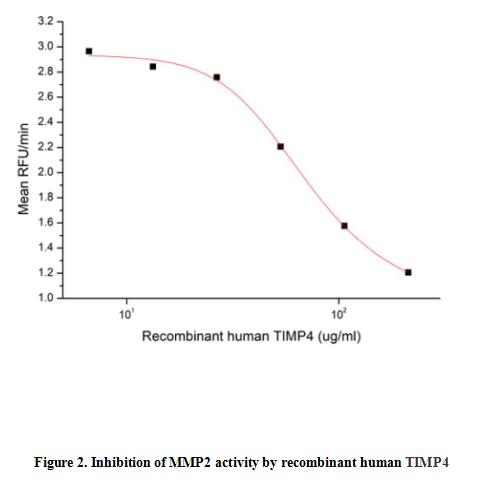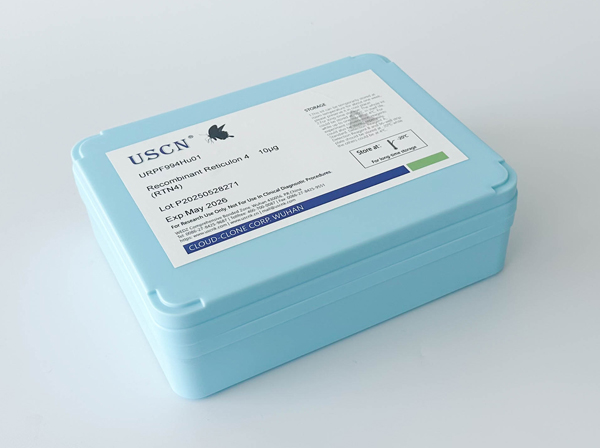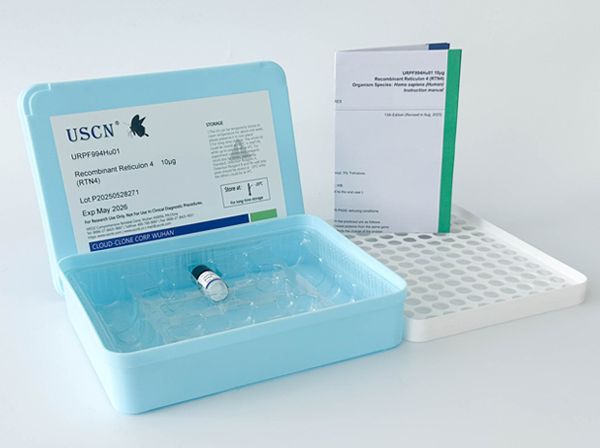組織金屬蛋白酶抑制因子4(TIMP4)活性蛋白
Active Tissue Inhibitors Of Metalloproteinase 4 (TIMP4)
TIMP Metallopeptidase Inhibitor 4; Tissue Inhibitor of Metalloproteinases 4
- 編號UAPA130Hu01
- 物種Homo sapiens (Human,人) 相同的名稱,不同的物種。
- 緩沖液成份20mM Tris, 150mM NaCl緩沖液(pH8.0, 含有1mM EDTA, 1mM DTT, 0.01% SKL, 5% Trehalose和Proclin300)
- 性狀凍干粉
- 純度> 90%
- 等電點7.2
- 應用Cell?culture;?Activity?Assays.
- 下載 英文說明書 中文說明書
- 規格 10μg50μg 200μg 1mg 5mg
- 價格 ¥ 1016 ¥ 2541 ¥ 5082 ¥ 15246 ¥ 38115
- 欲了解實際交易價格和更多情況,請與當地經銷商聯系!
活性實驗

Tissue Inhibitors Of Metalloproteinase 4 (TIMP4) is an enzyme that in humans is encoded by the TIMP4 gene. This gene belongs to the tissue inhibitor of metalloproteinases gene family. The proteins encoded by this gene family are inhibitors of the matrix metalloproteinases, a group of peptidases involved in degradation of the extracellular matrix. The secreted, netrin domain-containing protein encoded by this gene is involved in regulation of platelet aggregation and recruitment and may play role in hormonal regulation and endometrial tissue remodeling. Besides, Matrix Metalloproteinase 2 (MMP2) has been identified as an interactor of TIMP4, thus a binding ELISA assay was conducted to detect the interaction of recombinant human TIMP4 and recombinant human MMP2. Briefly, TIMP4 were diluted serially in PBS, with 0.01% BSA (pH 7.4). Duplicate samples of 100μL were then transferred to MMP2-coated microtiter wells and incubated for 2h at 37℃. Wells were washed with PBST and incubated for 1h with anti-TIMP4 pAb, then aspirated and washed 3 times. After incubation with HRP labelled secondary antibody, wells were aspirated and washed 3 times. With the addition of substrate solution, wells were incubated 15-25 minutes at 37℃. Finally, add 50μL stop solution to the wells and read at 450nm immediately. The binding activity of TIMP4 and MMP2 was shown in Figure 1, and this effect was in a dose dependent manner.

The activity of recombinant human TIMP4 was also measured by its ability to inhibit rhMMP2 cleavage of a fluorogenic peptide substrate MCA-Pro-Leu-Gly-Leu-DPA-Ala-Arg-NH2 in the assay buffer 50 mM Tris, 10 mM CaCl2, 150 mM NaCl, 0.05% (w/v) Brij-35, pH 7.5. rhMMP2 was diluted to 100 ug/ml and activated with 1 mM APMA at 37 °C for 1 hour and rhTIMP2 (MW: 51.75 KD) was diluted to different concentrations with the assay buffer. Mix 8 μl of rhTIMP2 curve dilutions, 12.8 μl of activated rhMMP-2, and 59.2 μl of assay buffer, including a control containing assay buffer and the diluted rhMMP-2 and incubate the reactions for 2 hours at 37 °C. Loading 50?μl of the incubated mixtures which were diluted five-fold in assay buffer into empty wells of a plate, and start the reaction by adding 50?μl of 20?μM substrate. Include a substrate blank containing 50?μl of assay buffer and 50?μl of 20?μM substrate. Then read at excitiation and emission wavelengths of 320 nm and 405 nm, respectively, in kinetic mode for 5 minutes. The result was shown in Figure 1 and it was obvious that recombinant human TIMP4 significantly decreased rhMMP2 activity. The inhibition IC50 was <70 nM.
用法
Reconstitute in 20mM Tris, 150mM NaCl (PH8.0) to a concentration of 0.1-1.0 mg/mL. Do not vortex.
儲存
避免反復凍融。2-8°C不超過一個月,-80°C不超過12個月。
穩定性
熱穩定性以損失率顯示。損失率是由加速降解試驗決定,具體方法如下:在37°C孵育48小時,沒有顯著的降解或者沉淀產生。保質期內,在適當的條件下存儲,損失率低于5%。
增值服務
相關產品
| 編號 | 適用物種:Homo sapiens (Human,人) | 應用(僅供研究使用,不用于臨床診斷!) |
| UAPA130Hu01 | 組織金屬蛋白酶抑制因子4(TIMP4)活性蛋白 | Cell?culture;?Activity?Assays. |
| URPA130Hu01 | 組織金屬蛋白酶抑制因子4(TIMP4)重組蛋白 | Positive Control; Immunogen; SDS-PAGE; WB. |
| UPAA130Hu01 | 組織金屬蛋白酶抑制因子4(TIMP4)多克隆抗體 | WB; IHC |
| UMAA130Hu22 | 組織金屬蛋白酶抑制因子4(TIMP4)單克隆抗體 | WB; IHC; ICC; IP. |
| USEA130Hu | 組織金屬蛋白酶抑制因子4(TIMP4)檢測試劑盒(酶聯免疫吸附試驗法) | Enzyme-linked immunosorbent assay for Antigen Detection. |
| USCA130Hu | 組織金屬蛋白酶抑制因子4(TIMP4)檢測試劑盒(化學發光免疫分析法) | Chemiluminescent immunoassay for Antigen Detection. |
| ULMA130Hu | 組織金屬蛋白酶抑制因子4(TIMP4)等多因子檢測試劑盒(流式熒光發光法) | FLIA Kit for Antigen Detection. |
參考文獻
| 雜志 | 參考文獻 |
| PLoS ONE | A Combinatorial Relative Mass Value Evaluation of Endogenous Bioactive Proteins in Three-Dimensional Cultured Nucleus Pulposus Cells of Herniated Intervertebral Discs: Identification of Potential Target Proteins for Gene Therapeutic Approaches [Plosone: Source] |




